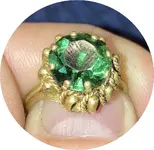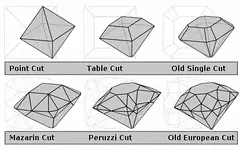Let me preface by stating....I'm no expert on gems or precious metals...nor am I a jeweler or a goldsmith.
I never knew of Austrian emeralds until "H.D." made the opening post of this thread. That being said, I base my opinions on
past saltwater detecting experience, acquired knowledge from over 60 years of my interest in antiquities/coins/art etc,. and deductive reasoning, (like many people here). Over the years I have found that even experts/professionals can be wrong on
appraisals of things. Authentic items can be judged as fake, & fake items can be judged as authentic & original.
Like many here, I also find "H.D.'s" ring interesting & intriguing but I am also puzzled & unsure with my limited knowledge
of such things. The shank/loop of the ring is puzzling to me also.....but, unless the ring was lost shortly before "H.D."
found it, I can't see it being brass. Brass in the sea for an extended period turns green or greenish blue. Plus, it's too hard
for an adjustable shank/loop. It has too be a softer metal & have pliability to it so it can be tightened around the finger.
The ring looks like it's a little misshapen on the right side. (green arrow) The shank/loop is not copper or aluminum either.
I would
guess that it is a high karat gold, (20-22k) that was rolled & folded over before being affixed to the bridge/crown/gallery/crest which may be of a lower carat (14-18k) for hardness, especially the prongs that hold the stone in place. (crown & shank/loop should be tested separately) If you magnify the pictures it seems the softer gold of the shank/loop
has dings & dents that don't seem to exist on the prongs & crown etc.
The "Made in Austria" with no maker's mark is puzzling. It
"possibly" could be one of those rings made with gold
but has an emerald
NOT from Austria as mentioned in the link in post#2 of this thread.
As for the stone/gem, also in the link of post#2, the Austrian stones can be distinguished from other countries' emeralds
by certain characteristics that a qualified gemologist
may be able to ascertain. Keep in mind that emeralds are 7.5-8 on the "MOH" scale. (Diamonds are hardest at 10). A good example of the durability of gems that have been knocked around in the sea is our fellow T-Netter "Mike B's" find of a beautiful 14-18k (I forget which) old ring with a diamond, ruby & sapphire. Found in saltwater, the gold was tarnished but the gems where unblemished.
"Hunting Dad", if your ring test positive for gold, you should contact the guy by the email he lists in the link of post#2.
He should shed some light on the subject seeing he is writing a book about it, & seems to be very knowledgeable about the
Austrian emeralds. I photo-chopped the ring from your hand, enlarged it & put it on a red background.
If you can get a back-lighted photo of your ring in an UPRIGHT position so that it shines through the gem, I will photo-chop it and put it on a background also. But, be sure when you send the guy the photos, you let him know that the images were
"photo-chopped" from an original photo, but the ring & gem themselves were not
"photo-shopped" in any way.
(just so he knows you're not misleading him) Best wishes. I hope your ring is the real deal. Great find nonetheless.
CHEERS !! J.T.G.


p.s. Don't polish the gold but you may want to clean out the dirt under the gem (red arrows) with water & a light tooth brush. Also, it may be worthwhile to check carefully for a maker's mark somewhere hidden in the crown/crest/galley/bridge areas.
Wild speculation: What does a goldsmith who owns an emerald mine do in his cabin @ night when he is not looking for emeralds in the middle eighteen hundreds? He didn't need electricity for light to do his gold smithing. There was none. Probably
did the same stuff he did when he was at home. Could Mr. Goldschmidt have been a gemstone cutter too? Wouldn't surprise me.












